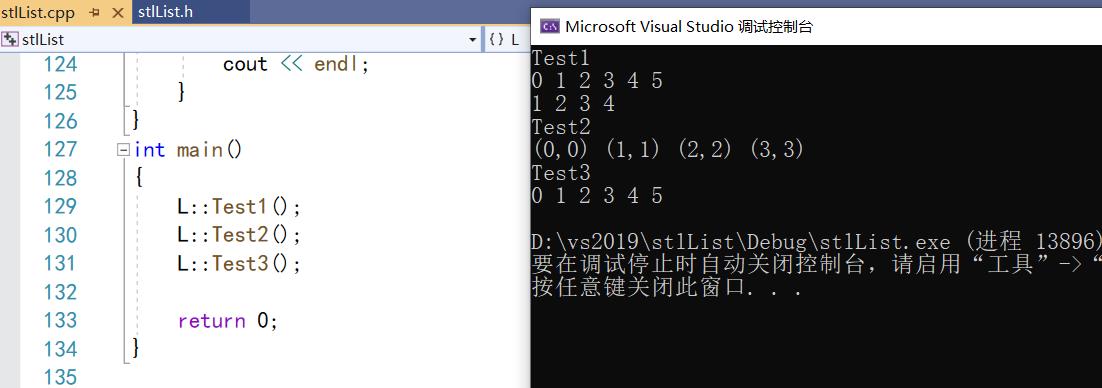c++:stl中list的模拟实现
Posted mbf330
tags:
篇首语:本文由小常识网(cha138.com)小编为大家整理,主要介绍了c++:stl中list的模拟实现相关的知识,希望对你有一定的参考价值。
文章目录
list
1、list的介绍及使用
(1)list的介绍/特点
- list是可以在常数范围内在任意位置进行插入和删除的序列式容器,并且该容器可以前后双向迭代。
- list的底层是带头双向链表结构,双向链表中每个元素存储在互不相关的独立节点中,在节点中通过指针指向其前一个元素和后一个元素。
- list与forward_list非常相似:最主要的不同在于forward_list是单链表,只能朝前迭代,已让其更简单高效。
- 与其他的序列式容器相比(array,vector,deque),list通常在任意位置进行插入、移除元素的执行效率更好。
- 与其他序列式容器相比,list和forward_list最大的缺陷是不支持任意位置的随机访问,比如:要访问list的第6个元素,必须从已知的位置(比如头部或者尾部)迭代到该位置,在这段位置上迭代需要线性的时间开销;list还需要一些额外的空间,以保存每个节点的相关联信息(对于存储类型较小元素的大list来说这可能是一个重要的因素)。
(2)list的使用/接口介绍
介绍部分常用接口
iterator迭代器
1.begin:返回第一个元素的迭代器
2.end:返回最后一个元素下一个位置的迭代器
3.rbegin:返回第一个元素的reverse_iterator,即end位置
4.rend:返回最后一个元素下一个位置的reverse_iterator,即begin位置
capacity容量
5.empty:检测list是否为空,是返回true,否则返回false
6.size:返回list中有效节点的个数
element access元素访问
7.front:返回list的第一个节点中值的引用
8.back:返回list的最后一个节点中值的引用
modifiers调节器
9.push_front:在list首元素前插入值为val的元素
10.pop_front;删除list中第一个元素
11.push_back:在list尾部插入值为val的元素
12.pop_back:删除list中最后一个元素
13.insert:在list pos位置中插入值为val的元素
14.erase:删除list pos位置的元素
15.swap:交换两个list中的元素
16.clear:清空list中的有效元素
2.list的模拟实现
(1)代码实现
#pragma once
#include <iostream>
#include <list>
#include <algorithm>
#include <assert.h>
using namespace std;
namespace L
template<class T>
struct ListNode
T _data;
ListNode<T>* _next;
ListNode<T>* _prev;
//构造函数:初始化节点
ListNode(const T& x = T())
: _data(x)
, _next(nullptr)
, _prev(nullptr)
;
//template<class T>
//迭代器iterator实现
//用struct实现:定义为公有,不必用友元函数进行调用
//Ref传T&(引用),Ptr传T*(指针)
template<class T, class Ref, class Ptr>
struct List_iterator
typedef ListNode<T> node;
typedef List_iterator<T, Ref, Ptr> self;
node* _node;
List_iterator(node* node)
:_node(node)
bool operator!=(const self& s) const
return _node != s._node;
bool operator==(const self& s) const
return !(*this != s);
//T*
Ptr operator->() const
return &_node->_data;
//T&
Ref operator*() const
return _node->_data;
// 后置++:it++ it.operator(&it, 0)
self operator++(int)
self tmp(*this);
_node = _node->_next;
return tmp;
// 前置++:++it it.operator(&it)
self& operator++()
_node = _node->_next;
return *this;
// 后置--:it--
self operator--(int)
self tmp(*this);
_node = _node->_prev;
return tmp;
//前置--:--it;
self& operator--()
_node = _node->_prev;
return *this;
;
template<class T>
class list
typedef ListNode<T> node;
private:
//双向带头循环list,
node* _head;
public:
typedef List_iterator<T, T&, T*> iterator;
typedef List_iterator<T, const T&, const T*> const_iterator;
//析构:清除数据后置为nullptr
~list()
clear();
delete _head;
_head = nullptr;
//
void clear()
iterator it = begin();
while (it != end())
erase(it++);
iterator begin()
return _head->_next;
iterator end()
return _head;
const_iterator begin() const
return _head->_next;
const_iterator end() const
return _head;
template<class InputIterator>
//拷贝构造函数函数模板实现
list(InputIterator first, InputIterator last)
_head = new node;
_head->_next = _head;
_head->_prev = _head;
while (first != last)
push_back(*first);
++first;
list(const list<T>& lt)
_head = new node;
_head->_next = _head;
_head->_prev = _head;
list<T> tmp(lt.begin(), lt.end());
std::swap(_head, tmp._head);
//lt1 = lt2:赋值:交换头节点即可,之后访问的便是另外一个list
list<T>& operator=(list<T> lt)
std::swap(_head, lt._head);
return *this;
//拷贝构造函数普通实现
/*list(const list<T>& lt)
_head = new node;
_head->_next = _head;
_head->_prev = _head;
const_iterator it = lt.begin();
while (it != lt.end())
push_back(*it);
++it;
*/
//构造函数:初始化list
list()
_head = new node;
_head->_next = _head;
_head->_prev = _head;
//插入
iterator insert(iterator pos, const T& x)
node* newnode = new node(x);
node* cur = pos._node;
node* prev = cur->_prev;
//顺序:prev newnode cur
prev->_next = newnode;
newnode->_prev = prev;
cur->_prev = newnode;
newnode->_next = cur;
return iterator(newnode);
//删除节点
iterator erase(iterator pos)
assert(pos != end());
node* cur = pos._node;
node* prev = cur->_prev;
node* next = cur->_next;
prev->_next = next;
next->_prev = prev;
delete cur;
return iterator(next);
//尾插:普通实现&&用insert以及end的迭代器实现
void push_back(const T& x)
//普通实现
/*node* newnode = new node(x);
node* tail = _head->_prev;
tail->_next = newnode;
newnode->_prev = tail;
newnode->_next=_head;
_head->_prev = newnode;*/
//insert实现尾插
insert(end(), x);
//头插:用insert以及begin的迭代器实现
void push_front(const T& x)
insert(begin(), x);
//头删:用erase以及begin的迭代器实现
void pop_front()
erase(begin());
//尾删:用erase以及end的迭代器实现
void pop_back()
erase(end());
;
(2)测试用例
#include "stlList.h"
namespace L
struct point
int x;
int y;
;
void Test1()
cout << "Test1" << endl;
list<int> lt;
lt.push_back(0);
lt.push_back(1);
lt.push_back(2);
lt.push_back(3);
lt.push_back(4);
lt.push_back(5);
list<int>::iterator it = lt.begin();
while (it != lt.end())
cout << *it << " ";
it ++;
cout << endl;
lt.pop_back();
lt.pop_front();
list<int> copy = lt;
for (auto e : copy)
cout << e << " ";
cout << endl;
void Test2()
cout << "Test2" << endl;
list<point> lt;
lt.push_back( 1,1 );
lt.push_back( 2,2 );
lt.push_back( 3,3 );
lt.push_front( 0,0 );
list<point>::iterator it = lt.begin();
while (it != lt.end())
//it->operator()->x;it->operator()->y;
cout << "(" << it->x << "," << it->y << ")" << " ";
it++;
cout << endl;
void Test3()
cout << "Test3" << endl;
list<int> lt;
lt.push_back(0);
lt.push_back(1);
lt.push_back(2);
lt.push_back(3);
lt.push_back(4);
lt.push_back(5);
//拷贝构造函数测试
list<int> copy = lt;
for (auto e : lt)
cout << e << " ";
cout << endl;
int main()
L::Test1();
L::Test2();
L::Test3();
return 0;
(3)运行截图

以上是关于c++:stl中list的模拟实现的主要内容,如果未能解决你的问题,请参考以下文章